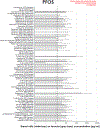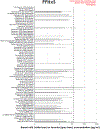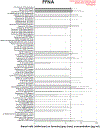Per- and polyfluoroalkyl substances (PFAS) in breast milk and infant formula: A global issue
- PMID: 36529330
- PMCID: PMC9872587
- DOI: 10.1016/j.envres.2022.115042
Per- and polyfluoroalkyl substances (PFAS) in breast milk and infant formula: A global issue
Abstract
Background: Per- and polyfluoroalkyl substances (PFAS) are transferred from mother to infants through breastfeeding, a time when children may be particularly vulnerable to PFAS-mediated adverse health effects. Infants can also be exposed to PFAS from infant formula consumption. Our recent literature-based scoping of breast milk levels reported that four PFAS often exceeded the United States Agency for Toxic Substances and Disease Registry (ATSDR) children's drinking water screening levels in both the general population and highly impacted communities in the U.S. and Canada. This work presents a comparison of global breast milk and infant formula PFAS measurements with the only reported health-based drinking water screening values specific to children.
Methods: We focused on four PFAS for which ATSDR has developed children's drinking water screening values: PFOA (perfluorooctanoic acid), PFOS (perfluorooctanesulfonic acid), PFHxS (perfluorohexanesulfonic acid), and PFNA (perfluorononanoic acid). Published literature on PFAS levels in breast milk and infant formula were identified via PubMed searches. Data were compared to children's drinking water screening values.
Discussion: Breast milk concentrations of PFOA and PFOS often exceed children's drinking water screening values, regardless of geographic location. The limited information on infant formula suggests its use does not necessarily result in lower PFAS exposures, especially for formulas reconstituted with drinking water containing PFAS. Unfortunately, individuals generally cannot know whether their infant's exposures exceed children's drinking water screening values. Thus, it is essential that pregnant and lactating women and others, especially those having lived in PFAS-contaminated communities, have data required to make informed decisions on infant nutrition. An international monitoring effort and access to affordable testing are needed for breast milk, drinking water and infant formula to fully understand infant PFAS exposures. Currently, our understanding of demonstrable methods for reducing exposures to emerging PFAS is limited, making this research and the communications surrounding it even more important.
Keywords: Children's drinking water screening values; Drinking water; Human milk; PFHxS; PFNA; PFOA; PFOS.
Copyright © 2022 The Authors. Published by Elsevier Inc. All rights reserved.
Conflict of interest statement
Declaration of competing interest The authors declare the following financial interests/personal relationships which may be considered as potential competing interest:Judy S. LaKind reports a relationship with National Academies of Sciences Engineering and Medicine that includes: consulting or advisory. Marc-Andre Verner served as a member on a National Academies of Sciences, Engineering and Medicine committee on PFAS, and reviewed documents related to PFAS for multiple agencies.
Figures





References
-
- Abdallah MA, Wemken N, Drage DS, Tlustos C, Cellarius C, Cleere K, Morrison JJ, Daly S, Coggins MA, Harrad S. 2020. Concentrations of perfluoroalkyl substances in human milk from Ireland: Implications for adult and nursing infant exposure. Chemosphere 246:125724. doi: 10.1016/j.chemosphere.2019.125724. Epub 2019 Dec 20. - DOI - PubMed
-
- Antignac JP, Veyrand B, Kadar H, Marchand P, Oleko A, Le Bizec B, Vandentorren S. 2013. Occurrence of perfluorinated alkylated substances in breast milk of French women and relation with socio-demographical and clinical parameters: results of the ELFE pilot study. Chemosphere 91(6):802–8. doi: 10.1016/j.chemosphere.2013.01.088. Epub 2013 Mar 7. - DOI - PubMed
Publication types
MeSH terms
Substances
Grants and funding
LinkOut - more resources
Full Text Sources
Medical

